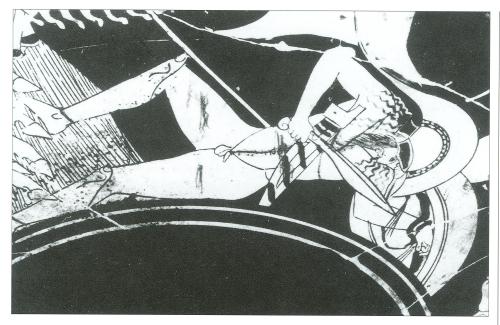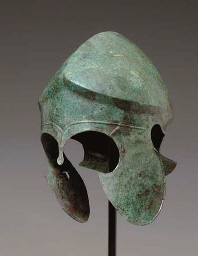By Periklis Deligiannis
The standard type of Attic/Athenian helmet of the Roman officers.
The Attic or Athenian helmet was an invention of the ancient Athenians, derived from a transformation of the older Chalkidean casque (or Chalkidian). The History of the Attic helmet spans to more than a thousand years and belongs paradoxically, more to the Italian-Roman rather than the Greek arsenal.
The ancestral Chalkidean helmet (6th century BC) was a “lighter” type of the even older and famous Corinthian or Dorian helmet (the typical helmet of the Classical Spartans). The Chalkidean helmet came from the attempt of the Chalkideans to solve the problem of the limited vision and hearing of the hoplite, because of his Corinthian helmet. The Chalkideans were the people of the city-state Chalkis in the island Euboea, famous for its weaponry during the Archaic Era (7th cent. – 479 BC). It seems that the Chalkidean helmet was popular in Athens and Attica, as we can see in the Athenian vase-paintings. This preference might be due partly to the Ionic ethnological affinities of the Athenians and Euboeans.
A typical Chalkidean bronze helmet
–
The Attic casque appeared in Athens around 500 BC as a local transformation of the Chalkidean. During the Persian Wars (490-479 BC) a number of Athenian hoplites used a Proto-attic type of helmet with a nose guard, but smaller enough than the nose guard of the typical Chalkidean. By 400 BC the nose guard was abolished and the Attic/Athenian helmet took its final shape. From the 4th century BC, the indigenous peoples of Italy adopted the Attic helmet en masse. The Etruscans, the Latins and the Early Romans used to wear it with raised cheek guards, even when they entered the battle. At the same time, the use of the Attic casque spread to the Lycians, the Carians and other native peoples of western Asia Minor.

A hoplite (a wounded mythical giant) with a Proto-attic helmet and a Kopis sword (vase-painting about 490 BC, Berlin, National Museum).
From the late 4th century BC, the Attic/Athenian helmet spread out across the Hellenistic and later the Greco-Roman world. Gradually, it was established informally as a helmet of the senior officers. In Italy, the Etruscans and the Oscans developed their own Etrusco-Attic and Osco-Attic types. Also the Apulian Oscans and the Messapians developed their own Apulo-Attic types.
An Osco-Attic helmet of the Lucanian Oscans of Southern Italy.
The Romans established the Hellenistic Attic helmet as the type worn by their senior officers, from the chiliarch (tribunus) up to the consul, including the emperor himself later (unlike the centurions and the common legionnaires who used “inelegant” Italian, Celtic and later Gallo-Roman types of helmets). At the same time, its use spread to additional Mediterranean peoples (Carthaginians and others).
A Roman tribunus with the Attic/Athenian helmet that characterized strongly his appearance.
The Attic-Athenian casque remained in Roman service until the fall of the Western Roman Empire (476 AD).
Simultaneously there was a “rebirth” of the Attic helmet in the Eastern (Byzantine) Empire, due to the “awakening” of the Greek elements of the state. In the Byzantine Empire, many ordinary soldiers used it after centuries of use exclusively by officers. Its use may finally have been abolished in the 7th century AD. The Attic-Athenian helmet was used for at least 1,100 years without interruption, by Italian-Roman, Greek and other armies. It was one of the most popular military helmets of World History.
–
–










Leave a comment